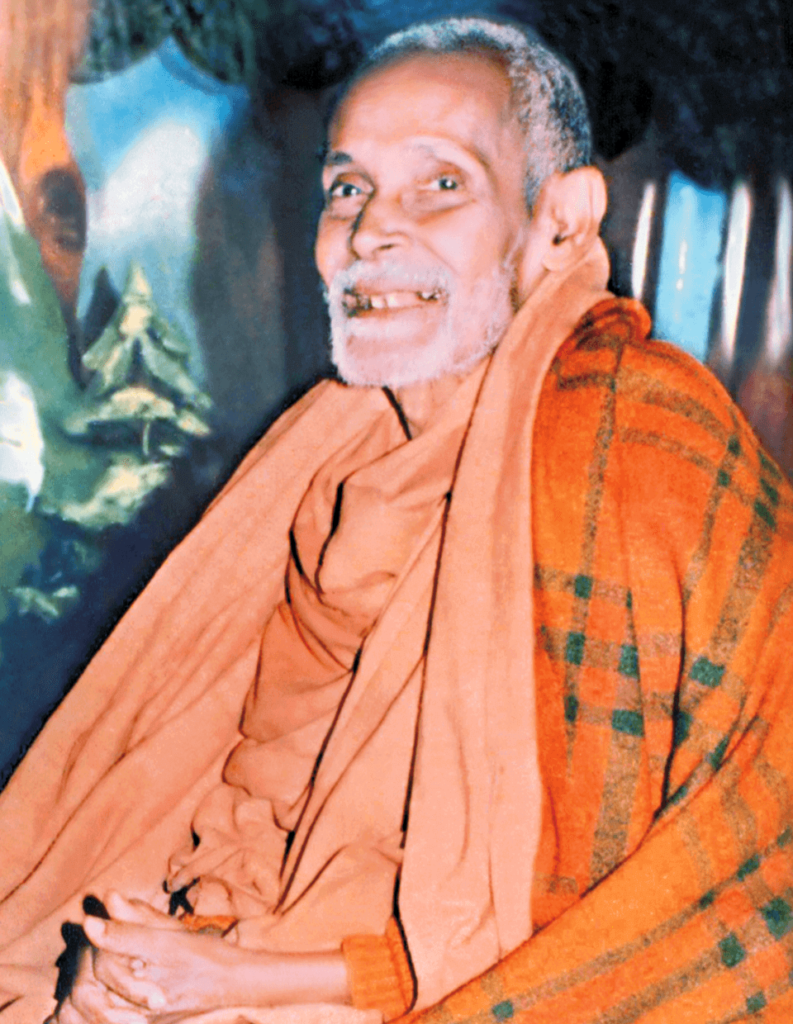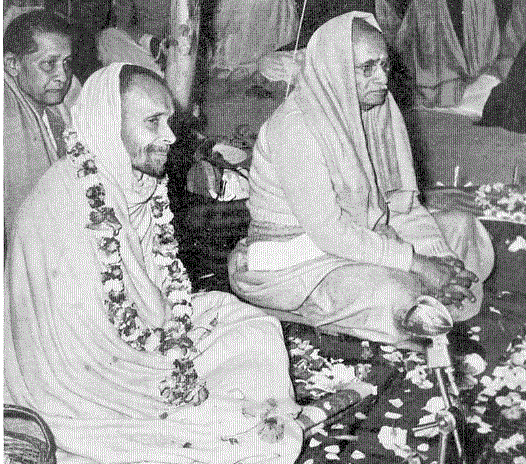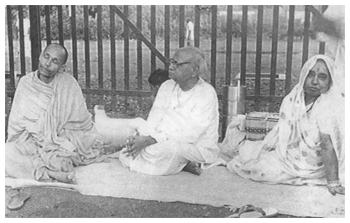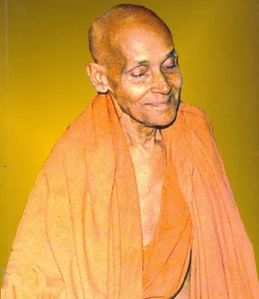
The Life and Spiritual Journey of Shri Radha Baba
Shri Radha Baba (16 January 1913 – 13 October 1992), was a great saint of Gorakhpur, revered for his deep spiritual insights, unparalleled simplicity, and unwavering devotion to Lord Krishna. Despite his profound wisdom and the transformative impact he had on Bhaktas who came into his circle, Radha Baba remained hidden from public attention throughout his life. He adhered strictly to the principle that a Sanyasi (renunciate) should never publicize himself. This strong belief in self-effacement and humility was one of the cornerstones of Radha Baba’s spiritual life. As a result, only those closely associated with Saint Shri Hanuman Prasad Poddar, popularly known as Bhaiji, were fortunate enough to come into contact with him, as Baba always remained with Bhaiji in the serene surroundings of Gita Vatika, Gorakhpur.
श्री राधा बाबा का जीवन और आध्यात्मिक यात्रा
श्री राधा बाबा (16 जनवरी 1913 – 13 अक्टूबर 1992) गोरखपुर के एक संत थे, जो अपनी आध्यात्मिकता, सादगी और भगवान कृष्ण के प्रति अटूट भक्ति के लिए जाने गए। उनके भक्तों पर उनके द्वारा डाले गए प्रभाव के बावजूद, राधा बाबा अपने पूरे जीवन में लोगों के ध्यान का केंद्र बनने से दूर ही रहे। उन्होंने इस सिद्धांत का दृढ़ता से पालन किया कि एक सच्चे सन्यासी को स्वयं को प्रचारित नहीं करना चाहिए। त्याग और विनम्रता में गहरी आस्था राधा बाबा के आध्यात्मिक जीवन की एक आधारशिला थी। इस कारण, केवल वे लोग जो संत श्री हनुमान प्रसाद पोद्दार (स्नेह से भक्तों के बीच भाईजी के नाम से जाने जाते थे) के निकट थे, उनसे संपर्क कर पाए, क्योंकि बाबा गोरखपुर के शांत वातावरण में स्थित गीता वाटिका में भाईजी के निकट रहते थे।
Early Life and Spiritual Foundations
Born as Shree Chakradhar Mishra also later known as Shree Radha Baba on January 16, 1913, in Bihar, in village Fakharpur was known for his exceptional intellectual abilities. His Father Mahipal Mishra was a great scholar and Dharmnishtha Brahman and Chakradhar Mishra was the fourth son of his parents. His mother Adhikarini Devi was also a very noble soul.
Radha baba in childhood mastered six to seven languages, demonstrating his brilliance as a scholar. However, his quest for higher knowledge led him beyond the realms of academics into the world of spirituality.
Shri Chakradhar Baba, and his early life was marked by a keen intellectual curiosity and a deep quest for spiritual understanding. Initially, Baba followed the path of Vedanta, the school of Indian philosophy that emphasizes self-realization and the oneness of the individual soul with the universal consciousness. He was a firm Vedantee, intellectually rigorous and uncompromising in his pursuit of truth through this path.
However, the turning point in Radha Baba’s life came when he met Shri Hanuman Prasad Poddar, a towering spiritual personality who was affectionately called Bhaiji. Shri Poddar was a deeply revered figure, well-known for his role in editing and popularizing spiritual literature through Gitapress, the most significant publisher of Hindu religious texts. Radha Baba came into contact with Bhaiji through another renowned spiritual figure, Jai Dayal Ji Goenka, the founder of Gitapress. It was this meeting that began Radha Baba’s transformation from an intellectual Vedantee to a Bhakti Margi (a devotee on the path of devotion).
प्रारंभिक जीवन और आध्यात्मिक आधार
श्री चक्रधर मिश्र, जिन्हें बाद में श्री राधा बाबा के नाम से जाना गया, का जन्म 16 जनवरी 1913 को बिहार के फखरपुर गाँव में हुआ था। उनके पिता महिपाल मिश्र एक विद्वान और धर्मनिष्ठ ब्राह्मण थे, और चक्रधर मिश्र अपने माता-पिता के चौथे पुत्र थे। उनकी माता, अधिकारिणी देवी भी एक अत्यंत पुण्यात्मा थीं।
बचपन में ही राधा बाबा ने छह से सात भाषाओं पर महारत हासिल कर ली थी, जिससे उनकी विद्वता का परिचय मिलता है। हालांकि, उच्च ज्ञान की उनकी खोज ने उन्हें शिक्षा के पार आध्यात्मिकता की ओर अग्रसर किया।
श्री चक्रधर बाबा का प्रारंभिक जीवन एक जिज्ञासु के रूप में आध्यात्मिकता के विषयों पर भिन्न भिन्न तरीकों की अपनी खोजों से भरा हुआ था। शुरुआत में बाबा ने वेदांत के मार्ग का अनुसरण किया, जो भारतीय दर्शन का महत्वपूर्ण अंग है जो आत्म-साक्षात्कार और आत्मा तथा ब्रह्मांडीय चेतना की एकता पर बल देता है। वे एक दृढ़ वेदांती थे, जो सत्य की खोज के लिए बौद्धिक रूप से संकल्पित थे।
हालांकि, राधा बाबा के जीवन में एक महत्वपूर्ण मोड़ तब आया जब उनकी मुलाकात भाईजी के नाम से जाने गए श्री हनुमान प्रसाद पोद्दार से हुई। भाईजी एक महान आध्यात्मिक व्यक्तित्व थे, जो गीता प्रेस गोरखपुर के माध्यम से आध्यात्मिक साहित्य को संपादित और प्रकाशित करवा कर लोकप्रिय बनाने के लिए जाने जाते थे, जो आज भी हिंदू धार्मिक ग्रंथों का सबसे प्रमुख प्रकाशक है। राधा बाबा का भाईजी से संपर्क जय दयाल जी गोयनका के माध्यम से हुआ, जो गीता प्रेस के संस्थापक थे। यही वह समय था जब पोद्दार जी के सानिध्य में श्री राधा बाबा की एक बौद्धिक वेदांती से भक्ति मार्गी (भक्ति के पथ का अनुयायी) में बदलने की यात्रा शुरू हुई।



Transformation from Vedant to Bhakti Marg
The shift from Vedanta to Bhakti Marg (the path of devotion) was not immediate for Radha Baba. During Bhakti Sadhna, he was deeply devoted to Tripur Sundari, a powerful manifestation of the Goddess in the tradition of Shakti worship. He achieved the highest realization in the tantrik cult of Tripur Sundari, attaining spiritual heights in that path.
Over time, under the influence and spiritual guidance of Shri Bhaiji, Radha Baba’s rigid Vedantic orientation gave way to the gentler, more emotional path of Bhakti, particularly devotion to Lord Krishna. He embraced Braj Sadhana, the form of spiritual practice that immerses one in the love and devotion of Lord Krishna, specifically in the spirit of Gopi and Radha Bhava — the devotional mood of Radha’s love for Krishna. This transformation marked the beginning of a new phase in Radha Baba’s life. From a dogmatic intellectual, he became a soft-hearted, deeply devoted Bhakta (devotee), fully immersed in the love of Krishna.
Radha Baba followed the spiritual tradition of Saint Shri Chaitanya Mahaprabhu, the 16th-century saint who epitomized the Bhakti movement through his intense love for Lord Krishna and ecstatic worship. Like Chaitanya, Radha Baba’s devotion expressed itself in Naam Sadhana (the practice of chanting the name of the Lord) and Bhava Samadhi (intense emotional absorption in divine love). These practices led him into profound states of spiritual ecstasy, during which he would lose all consciousness of the external world for days at a time.
वेदांत से भक्ति मार्ग की ओर परिवर्तन
वेदांत से भक्ति मार्ग (भक्ति के पथ) की ओर राधा बाबा का परिवर्तन एकदम से नहीं हुआ। भक्ति साधना के दौरान, भगवान कृष्ण के निर्देशानुसार वे त्रिपुर सुंदरी, जो शक्ति उपासना की परंपरा में देवी का एक शक्तिशाली रूप हैं, की आराधना की । त्रिपुर सुंदरी की तांत्रिक उपासना में उन्होंने उच्चतम आध्यात्मिक सिद्धि प्राप्त की और इस मार्ग में वे उच्च स्तरों तक पहुंचे।
समय के साथ, भाईजी के मार्गदर्शन में राधा बाबा की कठोर वेदान्तिक प्रवृत्ति एक कोमल और भावनात्मक भक्ति मार्ग की ओर मुड़ गई, विशेष रूप से भगवान कृष्ण के प्रति। उन्होंने ब्रज साधना को अपनाया, जो भगवान कृष्ण के प्रेम और भक्ति में डूबने की साधना है, विशेषकर गोपी और राधा भाव में — राधा के प्रेम के भाव में कृष्ण के प्रति। यह परिवर्तन राधा बाबा के जीवन में एक नए चरण की शुरुआत थी। एक कट्टर बौद्धिक से, वे एक कोमल हृदय वाले, भक्ति से पूरित भक्त बन गए, जो कृष्ण के प्रेम में पूरी तरह डूब गए थे। राधा भाव से कृष्ण की उपासना के कारण उन्हें राधा बाबा के नाम से जाना गया।
राधा बाबा ने संत श्री चैतन्य महाप्रभु की परंपरा का अनुसरण किया, जो 16वीं शताब्दी के संत थे और जिन्होंने भक्ति आंदोलन में कृष्ण के प्रति अपने गहन प्रेम और भक्ति का परिचय दिया। चैतन्य महाप्रभु की तरह, राधा बाबा की भक्ति नाम साधना (भगवान के नाम का जप) और भाव समाधि (दिव्य प्रेम में गहन भावनात्मक अभिव्यक्ति) में प्रकट हुई। इन साधनाओं ने उन्हें गहन आध्यात्मिक आनंद की अवस्थाओं में पहुंचा दिया, जहां वे कई दिनों तक बाहरी दुनिया से पूरी तरह अनभिज्ञ रहते थे।
A Life of Austerity and Devotion
Radha Baba’s life was marked by extreme austerity, a rarity even among saints of his time. He adhered to a strict discipline of eating and drinking only once a day throughout his life. This simple and disciplined way of living was not for show or fame; it was an expression of his spiritual conviction. He never touched money, nor did he allow any luxuries to enter his life. His absolute renunciation of material comforts was an embodiment of his spiritual ideals.
Baba’s bond with Shri Bhaiji was profound, and they shared a unique spiritual relationship. They lived together in Gita Garden in Gorakhpur, a serene and spiritually charged space that attracted devotees. Those who followed Bhaiji naturally became acquainted with Radha Baba, but Baba never sought followers or fame for himself. His humility was such that even though he was an outstanding writer and poet, he never published his works under his own name. Instead, his books and writings were anonymously attributed to “Ek Sadhu” (a monk). His poems, steeped in devotion, were an expression of his deep spiritual experiences, but they, too, remained unsigned.
तप और भक्ति का जीवन
राधा बाबा का जीवन कठोर तप और सादगी से भरा था, जो उस समय के संतों में भी दुर्लभ था। उन्होंने अपने पूरे जीवन सख्त अनुशासन का पालन किया, जिसमें वे दिन में केवल एक बार भोजन और जल ग्रहण करते थे। उनका यह सरल और अनुशासित जीवन किसी दिखावे के लिए नहीं था, बल्कि उनके आध्यात्मिक विश्वास की एक अभिव्यक्ति था। उन्होंने कभी धन को हाथ नहीं लगाया और न ही किसी विलासिता का कभी आनंद लिया। भौतिक सुख-सुविधाओं से उनका पूर्ण त्याग उनके आध्यात्मिक आदर्शों का प्रतीक था।
बाबा का श्री भाईजी के साथ गहरा संबंध था, और उनका एक अनोखा आध्यात्मिक रिश्ता था। वे दोनों गोरखपुर के शांतिपूर्ण और आध्यात्मिक रूप से प्रबुद्ध स्थान गीता वाटिका में साथ रहते थे, जो भक्तों को आकर्षित करता था। जो लोग भाईजी का अनुसरण करते थे, वे स्वाभाविक रूप से राधा बाबा से परिचित हो ही जाते थे, लेकिन बाबा ने कभी भी अपने लिए अनुयायियों या प्रसिद्धि की चाह नहीं रखी। उनकी विनम्रता इतनी थी कि वे एक उत्कृष्ट लेखक और कवि होते हुए भी अपने कार्यों को अपने नाम से प्रकाशित नहीं करते थे। उनकी पुस्तकों और लेखों को गुमनाम रूप से “एक साधु” के रूप में प्रस्तुत किया जाता था। उनकी भक्ति से ओत प्रोत कविताएँ उनके गहरे आध्यात्मिक अनुभवों की अभिव्यक्ति थीं, लेकिन वे भी बिना हस्ताक्षर के रहीं।
Spiritual Practices and Teachings
Radha Baba’s spiritual practice was centered around the chanting of Bhagwan Naam Jap (repetition of the divine name). He believed that chanting the name of God was the highest form of spiritual practice and that sincere, faith-filled prayer was the most powerful tool for spiritual realization. For him, prayer and the repetition of the Lord’s name could never fail if done with full devotion and faith.
Although Radha Baba reached extraordinary spiritual heights, he never disclosed his achievements, nor did he make disciples. His spirituality was intensely personal, and he sought no recognition for it. Baba’s deep states of Samadhi (divine absorption) were witnessed by those close to him, as he would remain in these states for days, completely detached from the world. Even he remained “kashth maun”- state of complete silence even not expressing through gestures, for fifteen years straight away.
आध्यात्मिक साधनाएँ और शिक्षाएँ
राधा बाबा की आध्यात्मिक साधना भगवान नाम जप (भगवान के नाम का जप) पर केंद्रित थी। उनका मानना था कि भगवान के नाम का जप सबसे उच्चतम आध्यात्मिक साधना है और कि सच्चे विश्वास के साथ की गई प्रार्थना आत्म-साक्षात्कार के लिए सबसे शक्तिशाली साधन है। उनके अनुसार, यदि पूरी भक्ति और विश्वास के साथ प्रार्थना और भगवान का नाम जप किया जाए तो वह कभी असफल नहीं हो सकता।
राधा बाबा ने आध्यात्म के उच्च स्तर को प्राप्त किया, लेकिन उन्होंने कभी भी अपने आध्यात्मिक उपलब्धियों का खुलासा नहीं किया और न ही कोई शिष्य बनाया। उनकी आध्यात्मिकता और अनुभव बहुत ही व्यक्तिगत थे, और उन्होंने इसके लिए कभी प्रसिद्धि की कामना नहीं की। बाबा की गहरी समाधि अवस्थाओं का साक्षात्कार उनके निकट रहने वाले लोगों ने किया, क्योंकि वे इन अवस्थाओं में कई दिनों तक दुनिया से पूरी तरह से विच्छिन्न रहते थे। यहाँ तक कि उन्होंने लगातार पंद्रह वर्षों तक “काष्ठ मौन” (पूर्ण मौन जिसमें कोई संकेत भी न करना) में बिताया जो अपने आप में एक एक अत्यंत कठोर साधना है।
Legacy of a Hidden Saint
Shri Radha Baba’s life was an extraordinary example of humility, devotion, and renunciation. He lived quietly, in the shadow of his mentor, Shri Hanuman Prasad Poddar, and never sought personal recognition. His greatness lies not only in his spiritual accomplishments but also in his refusal to publicize them. His devotion to Lord Krishna, his commitment to austerity, and his poetic expression of divine love continue to inspire those who seek to follow the path of Bhakti.
Although he left no formal disciples, Radha Baba’s teachings on the power of prayer, the importance of chanting the divine name, and the beauty of a life devoted to God continue to resonate with the devotees who revere him. His life serves as a powerful reminder that true spirituality lies not in external recognition, but in the quiet, unwavering pursuit of divine love.His last wish was to leave the material body near the Samadhi of Hanuman Prasadji Poddar was fulfilled.He was a sankalp siddha saint and left the body by his will. He once promised his mentor Bhaiji to take care of Maaji till she remains in body. Soon after Maaji left her body, with serene resolve, the saint transcended mortality, his spirit ascending to divine realms by sheer will. Baba left this physical body on 13th October ,1992 in Gorakhpur and his beautiful Samadhi was created near the samadhi of Bhaiji Hanuman Prasadji Poddar
एक संत की विरासत
श्री राधा बाबा का जीवन विनम्रता, भक्ति और त्याग का उदाहरण था। उन्होंने चुपचाप अपने गुरु श्री हनुमान प्रसाद पोद्दार की छाया में जीवन बिताया और कभी व्यक्तिगत मान्यता की इच्छा नहीं की। उनकी महानता न केवल उनकी आध्यात्मिक उपलब्धियों में थी, बल्कि इसमें भी थी कि उन्होंने इन्हें प्रचारित करने से मना किया। उनकी कृष्ण के प्रति भक्ति, समर्पण और दिव्य प्रेम की काव्यात्मक अभिव्यक्ति प्रियतम काव्य , उन लोगों को प्रेरित करती रहती है जो भक्ति के मार्ग का अनुसरण करना चाहते हैं।
हालाँकि उन्होंने कोई औपचारिक शिष्य नहीं बनाए, परन्तु राधा बाबा की प्रार्थना की शक्ति, भगवान के नाम के जप का महत्व, और एक जीवन जो पूरी तरह से भगवान को समर्पित हो, की उनकी शिक्षाएँ आज भी उनके भक्तों के बीच प्रतिध्वनित होती हैं। उनका जीवन एक शक्तिशाली अनुस्मारक है कि सच्ची आध्यात्मिकता बाहरी मान्यता में नहीं, बल्कि दिव्य प्रेम की निरंतर और अडिग खोज में निहित है। उनकी अंतिम इच्छा थी कि वे श्री हनुमान प्रसाद जी पोद्दार की समाधि के पास अपने शरीर को त्यागें और यह इच्छा पूरी हुई। वे संकल्प सिद्ध संत थे जिन्होंने अपनी इच्छा से शरीर का त्याग किया। उन्होंने अपने गुरु भाईजी को यह वचन दिया था कि वे श्री हनुमान प्रसाद जी पोद्दार की धर्म पत्नी जिन्हें सब माँजी कहते थे की देखभाल उनके जाने के बाद करेंगे, तब तक जब तक वे शरीर में रहेंगी। पूज्य माँजी के शरीर त्यागते ही, कुछ दिनों बाद शांत संकल्प के साथ इस संत ने मृत्यु को स्वीकार किया, और उनका आत्मा गोलोक प्रस्थान कर गयी। राधा बाबा ने 13 अक्टूबर, 1992 को गोरखपुर में इस भौतिक शरीर को त्याग दिया और उनकी सुंदर समाधि भाईजी हनुमान प्रसाद पोद्दार जी की समाधि के पास बनाई गई।